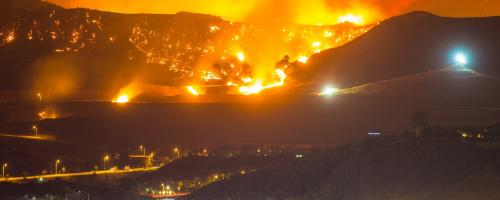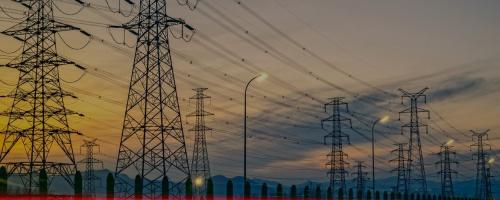Wildfires are substantial threats to a growing number of communities and infrastructure, so it is essential for public power utilities to adopt proactive measures in risk management and mitigation. Wildfire mitigation planning is crucial for public power utilities to ensure the resilience and reliability of electricity supply, reduce risks and associated costs, enhance public safety, and comply with regulatory standards. The American Public Power Association curated the following collection of resources to assist utilities in crafting their wildfire mitigation plans. Accessing these tools, expertise, and strategies can help utilities develop a robust wildfire mitigation plan to effectively address wildfire risks and protect their communities from the devastating effects of wildfires.
The Importance of Mitigation Planning
Investing in wildfire mitigation not only protects utility infrastructure but also contributes to the overall safety, reliability, and sustainability of the communities served. By implementing proactive measures such as vegetation management and strategic equipment placement, utilities can minimize the impact of wildfires on operations and community well-being. Effective mitigation planning also supports long-term sustainability by integrating climate-resilient practices into utility operations and fostering adaptive strategies to manage evolving risks.
Creating a Mitigation Plan
Creating and implementing a wildfire mitigation plan involves first fully understanding the potential risks and vulnerabilities facing different parts of your service territory when it comes to wildfire, including unique hardships various community members might face in mitigating risk. Once you understand the risks to your assets and within your community, you can then establish clear goals, identify relevant mitigation strategies, and sketch out an action plan for implementing the strategies in an achievable time frame. An effective wildfire mitigation plan involves community collaboration and regular updates in response to changing conditions or new information.
New Wildfire Mitigation Resources
 |  |
| Wildfire Mitigation Strategies & Resources | Wildfire Mitigation Plan Template |
Assess for Risk and Vulnerabilities
Various factors contribute to the likelihood that wildfires will occur in or spread across a specific area. This includes environmental conditions such as vegetation density, weather patterns (like drought and high temperatures), topography, and human activities like land use and ignition sources. In recent years, wildfire risk has increased, including in areas that have previously not experienced much risk. This is driven by rising temperatures, prolonged droughts, and human activities such as urban expansion into wildland areas, increased use of fire-prone landscapes for agriculture or recreation, and inadequate land management practices.
According to data from the National Interagency Fire Center, the average annual acreage burned by wildfires has more than doubled since the 1980s. In California alone, several record-breaking wildfire seasons from 2015 to 2020 led to significant impacts on communities and critical infrastructure, including seeing more than 4 million acres burned in 2020.
Resources for Utilities and Public Facilities
- Wildfire Risk and Changing Utility Business Models
- A Pacific Northwest National Laboratory (PNNL) initiative supported by the U.S. Department of Energy to examine how increasing wildfire threats are transforming utility business models. The project provides data-driven insights into financial and regulatory shifts, including rising insurance costs, liability exposure, asset valuation changes, and the redistribution of wildfire-related risks. It aims to document the evolving realities utilities face in wildfire-prone environments without introducing new risks.
- National Interagency Fire Center Open Data Site
- This resource contains georeferenced data detailing the ignition sources, observed fire behavior, and suppression strategies employed during past wildfire events. These datasets and maps, updated regularly, serve as valuable tools for wildfire management and academic research purposes.
- National Interagency Fire Enterprise Geospatial Portal
- The portal serves as the definitive source of standardized geospatial data covering all aspects of wildfire activities, including response, planning, and situational awareness. The portal provides updated information on ignition sources, fire behavior observations, suppression strategies, and other critical data essential for wildfire management and research purposes.
- United States Geological Service Fire Danger Forecast
- This resource merges forecasted weather data and satellite observations to produce various products that assess the potential for large-scale fire activity across the contiguous United States. These forecast products are generated up to seven days in advance and are updated daily to provide current and reliable information on fire risk.
- Wildfire Risk to Communities
- Free interactive maps, charts, and resources to assist communities in comprehending, investigating, and mitigating wildfire risk. Developed by the USDA Forest Service, this is the first nationwide mapping of wildfire risk to communities. the site aims to support community leaders—including elected officials, urban planners, and fire managers.
- FEMA National Risk Index | Wildfire
- This resource incorporates data from the U.S. Census to provide metrics on age, poverty levels, and the number of civilians with disabilities in each area, specifically in relation to wildfire disasters.
- Wildland Fire Risk Assessment Templates and Products - Bureau of Indian Affairs
- National Weather Service | Past Weather Forecast
- Provides previous weather forecast and climate data.
- A Wildfire Risk Assessment Framework for Land and Resource Management - U.S. Department of Agriculture
- Sections 1 and 2: Provides an overview of the risk assessment framework which Managers and decision makers could find valuable.
- Sections 7 and 8: Describes the value of risk assessment and its role for informing decisions.
Resources for Homes and Businesses
- Community Wildfire Risk and Hazard Assessment Tool - Fire Safe Sonoma
- Firewise USA®
- National Fire Protection Association
- Vegetation and Landscaping Guidance
- Living with Wildfire - Insurance Institute for Business & Home Safety
Creating Strategies and Action Plans
Putting your plan into action means carefully thinking through the priorities and low-hanging fruit to achieving your goal(s). It’s also about recognizing the opportunities for partnering with state and local agencies and organizations and in getting funding or other resources to be able to carry out aspects of the plan.
Sample mitigation plans and templates
- Wildfire Mitigation Plans Database - Pacific Northwest National Laboratory
- Wildfire Mitigation Reference Guide – NERC
- Electric Utility Wildfire Mitigation Plan Template – Washington Department of Natural Resources
- Wildfire Mitigation Plan Guidelines Template – California Public Utilities Commission
- Power System Wildfire Risks and Potential Solutions – NREL
- Wildfire Mitigation Strategies Guidebook – PG&E
- Wildfire Mitigation: Materials Science and Wood Pole Protection – North American Wood Pole Council
Collaboration and Funding Opportunities
- PNNL Wildfire Insights and Support for Electric (WISE) Utilities
- Fire Adapted Communities Learning Network
- Hazard Mitigation Assistance Grant Programs - FEMA
- Wildfire Mitigation Grant Opportunities - FEMA
- National Association of State Foresters
Peruse the Public Power Suppliers Guide to find potential vendors and consultants that can help develop or implement mitigation strategies.





